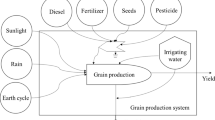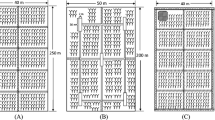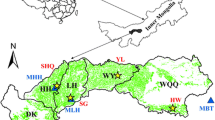Abstract
Sustainable water use is seriously compromised in the North China Plain (NCP) due to the huge water requirements of agriculture, the largest use of water resources. An integrated approach which combines the ecosystem model with emergy analysis is presented to determine the optimum quantity of irrigation for sustainable development in irrigated cropping systems. Since the traditional emergy method pays little attention to the dynamic interaction among components of the ecological system and dynamic emergy accounting is in its infancy, it is hard to evaluate the cropping system in hypothetical situations or in response to specific changes. In order to solve this problem, an ecosystem model (Vegetation Interface Processes (VIP) model) is introduced for emergy analysis to describe the production processes. Some raw data, collected by investigating or observing in conventional emergy analysis, may be calculated by the VIP model in the new approach. To demonstrate the advantage of this new approach, we use it to assess the wheat-maize rotation cropping system at different irrigation levels and derive the optimum quantity of irrigation according to the index of ecosystem sustainable development in NCP. The results show, the optimum quantity of irrigation in this region should be 240–330 mm per year in the wheat system and no irrigation in the maize system, because with this quantity of irrigation the rotation crop system reveals: best efficiency in energy transformation (transformity = 6.05E + 4 sej/J); highest sustainability (renewability = 25%); lowest environmental impact (environmental loading ratio = 3.5) and the greatest sustainability index (Emergy Sustainability Index = 0.47) compared with the system in other irrigation amounts. This study demonstrates that application of the new approach is broader than the conventional emergy analysis and the new approach is helpful in optimizing resources allocation, resource-savings and maintaining agricultural sustainability.







Similar content being viewed by others
References
Agostinho F, Diniz G, Siche R, Ortega E (2008) The use of emergy assessment and geographical information system in the diagnosis of small family in Brazil. Ecological Modelling 210:37–57
Boustead I, Hancock GF (1981) Energy and materials requirements of primary aluminum production in the UK. Resource Recovery and Conservation 5:303–318
Brown MT, Ulgiati S (2004) Emergy analysis and environmental accounting. Encyclopedia Energy 2:329–354
Brown MT, Arding J (1991) Transformities working paper, center for wetlands, University of Florida, Gainesville. FL. Accessed online November 5, 2009. http://www.emergysystems.org
Brown MT, Herendeen J (1996) Embodied energy analysis and emergy analysis: a comparative view. Ecological Economics 19:219–235
Brown MT, Ulgiati S (1997) Emergy-based indices and ratios to evaluate sustainability: monitoring economies and technology toward environmentally sound innovation. Ecological Engineering 9:51–69
Brown MT, Vivas MB (2005) Landscape development intensity index. Environmental Monitoring and Assessment 101:289–309
Buenfil AA (2001) Emergy evaluation of water. Department of Environmental Engineering Science, University of Florida, Gainesville, USA, 64 pp
Cavalett O, Queirroz JF, Ortega E (2006) Emergy assessment of integrated production system of grains, pig and fish in small farms in the South Brazil. Ecological Modelling 193:205–224
Chen ZY, Chen JS, Fei YH (2006) Estimate of groundwater renewal rate by tritium in the piedmont plain of the Taihang Mountains. Nuclear Techniques 29(6):426–431 (in Chinese)
Chen DD, Gao WS, Sui P (2008) Dynamic analysis on energy efficiency of modern planting system and grain production - a case study of Luancheng, Hebei. Progress in Geography 27(1):99–104 (in Chinese)
Cohen MJ, Brown MT, Shepherd KD (2006) Estimating the environmental costs of soil erosion at multiple scales in Kenya using emergy synthesis. Agriculture, Ecosystems & Environment 114:249–269
Dong XB, Ulgiati S, Yan MC, Zhang XS, Gao WS (2008) Energy and emergy evaluation of bioethanol production from wheat in Henan province, China. Energy Policy 36:3882–3892
Feng XJ, Gao HW, Li HW, Wang XY (2008) Monitoring and test of wind erosion in farm land around Beijing. Journal of Agricultural Mechanization Research 1:142–144 (in Chinese)
Fu GB, Charles SP, Yu JJ, Liu CM (2009) Decadal climatic variability, trend, and future scenarios for the North China Plain. Journal of Climate 22(8):2111–2123
Higgins JS (2003) Emergy analysis of the oak opening region. Ecological Engineering 21:75–109
Jiang MM, Chen GQ (2006) Emergy analysis of Chinese society 1980–2004. Systems Ecology Reports. National Laboratory for Turbulence and Complex Systems. Peking University, Beijing, China
Lan SF, Qin P, Lu HF (2002) Emergy analysis of ecoeconomic system. Chemical Industry Press, Beijing (in Chinese)
Lefory E, Rydberg T (2003) Emergy evaluation of three cropping systems in southwestern Australia. Ecological Modelling 161:195–211
Li BQ, Sun HY, Zhang XY, Shen YJ, Dong BD, Hu CS (2007) Analysis of irrigation demands and evapotranspiration in the piedmont of Taihang Mountain. Transactions of Chinese Society of Agricultural Engineering (CSAE) 23(2):26–30 (in Chinese)
Liu CM, Zhang XY, Zhang YQ (2002) Determination of daily evaporation and evapotraspiration of winter wheat and maize by large-scale weighing lysimeter and miro-lysimeter. Agricultural and Forest Meteorology 111:109–120
Lotka AJ (1922) Contribution to the energetic of evolution. Process of the National Academy of Science of the United States of America (PNAS) 8:147–150
Lou HH, Kulkarni MA, Singh A, Hopper JR (2004) Sustainability assessment of industrial systems. Industrial & Engineering Chemistry Research 43:4233–4242
Lu HF, Campbell DE, Li ZA, Ren H (2006) Emergy synthesis of an agro-forest restoration system in lower subtropical China. Ecological Engineering 27:175–192
Mo XG, Liu SX (2001) Simulating evapotranspiration and photosynthesis of winter wheat over the growing season. Agricultural and Forest Meteorology 109:203–222
Mo XG, Liu SX, Lin ZH (2004) Simulating temporal and spatial variation of evapotranspiration over the Lushi basin. Journal of Hydrology 285:125–142
Mo XG, Liu SX, Lin ZH, Guo RP (2009) Regional crop yield, water consumption and water use efficiency and their resonses to climate change in the North China Plain. Agriculture Ecosystems & Environment 134:67–78
Odum HT (1988) Self organization, transformity, and information. Science 242:1132–1139
Odum HT (1994) Ecological and General Systems: An Introduction to System Ecology. University Press of Colorado, revised edition of Systems Ecology, 1983, John Wiley& Sons, USA, New York 644 pp
Odum HT (1996) Environmental Accounting: emergy and environmental decision making. Wiley, New York, USA
Odum HT, Peterson N (1996) Simulation and evaluation with energy systems blocks. Ecological Modelling 93:155–173
Odum HT, Doherty SJ, Scatena FN, Kharecha PA (2000) Emergy evaluation of reforestation in Puerto Rico. Forest Science 46(4):521–530
Singh PK, Mishra AK, Imtiyaz M (1991) Moisture stress and the water use efficiency of mustard. Agricultural Water Management 20:253–254
Sun HY, Liu CM, Zhang XY, Shen YJ, Zhang YQ (2006) Effect of irrigation on water balance, yield and WUE of winter wheat in the North China Plain. Agricultural Water Management 85:211–218
Tilley DR, Brown M (2006) Dynamic emergy accounting for assessing the environmental benefits of subtropical wetland stormwater management systems. Ecological Modelling 192:327–361
Tilley DR, Swank WT (2003) Emergy-based environmental systems assessment of a multi-purpose mixed-forest watershed of the Southern Appalachian amaountains, USA. Journal of Environment Management 69(3):213–227
Ulgiati S, Odum HT, Bastianoni S (1994) Emergy use, environmental loading and sustainability. An emergy analysis in Italy. Ecological Modelling 73:215–268
Wu LZ, Cai ZC (2006) The relationship between the spatial and the variation of soil organic matter in China. Advances in Earth Science 21(9):965–972 (in Chinese)
Yang H, Shen J, Hu S (2003) Evaluating waster treatment, recycle and reuse in industrial system: an application of the emergy approach. Ecological Modelling 73:215–268
Yang YH, Watanabe M, Zhang XY, Hao XH, Zhang JQ (2006) Estimation of groundwater use by crop production simulated by DSSAT-wheat and DSSAT-maize models in the piedmont region of the North China Plain. Hydrological Processes 20(13):2787–2802
Zhao S, Li ZZ, Li WL (2005) A modified method of ecological footprint calculation and its application. Ecological Modelling 185:65–75
Acknowledgments
This research was jointly supported by the Chinese National Nature Science Foundation (Project No.40671033), Chinese Ministry of Science and Technology 863 Agriculture High Technology Project (2006AA10Z228) and State Key Lab of Resources and Environmental Information System (Project No. A0619). Many thanks to the four anonymous reviews and the Editor whose pertinent comments have greatly improved the quality of this article.
Author information
Authors and Affiliations
Corresponding author
Additional information
This is a contribution to the special issue of Environmental Impacts of Bioenergy (in China), Guest Editor Jie (Joe) Zhuang.
Appendix
Appendix
Calculations and References to Table 4
1 Sun: Mean annual global radiation of 5240 MJ/m2. Albedo = 20%. Energy received over land = 10000 m2 × 5.24 × 109 J/m2 × (1–20%) = 4.19 × 1013 J/ha year. Transformity = 1 (Odum 1996a, b).
2 Rain, chemical energy: Precipitation = 349.8 mm, evapotransipiration of crop = 430~800 mm (calculate by VIP model). Chemical energy of rain over land = 10000 m2 × 0.43~0.8 m (evapotransipiration) × 1000 kg/m3 (density of rain) × 4940 J/kg (Gibbs free energy of rainwater) = 2.12E + 10~3.95E + 10 J. Transformity from Odum (1996a, b).
3, 5 Groundwater: Annual groundwater consumption = 60~540 mm. Renewable part is 60~240 mm, nonrenewable part is 0~300 mm. Chemical energy of groundwater over land = 10000 m2 × 0.06~0.54 m (evapotransipiration) × 1000 kg/m3 (density of rain) × 4940 J/kg (Gibbs free energy of rainwater) = 0.30E + 10~2.67E + 10 J. Renewable part is 0.3E + 10~1.19E + 10 J, nonrenewable part is 0~1.48E + 10 J. Transformity from Buenfil (2001).
4 Soil loss: Average soil loss = 8.45t/ha (Feng and others 2008), organic matter = 0.01972 kg/kg soil (Wu and Cai 2006). Energy of soil loss = 8.45 × 103kg/ha × 0.01972 kg/kg × 5400 kcal/kg (organic matter energy) × 4186 J/kcal = 3.77E + 09 J. Transformity from Brown and Arding (1991).
6 Seed: Annual consumption is 1.40E + 05 g/ha, where 1.20E + 05 g/ha is used in the wheat growing stage and 0.2E + 05 g/ha is used in the maize growing stage (Heibei statistical yearbook, 2007). Energy of seed = 1.20E + 05 g/ha × 1.57E + 04 J/g + 0.2E + 05 g/ha × 1.65 E + 04 J/g = 2.22E + 09 J. Transformity from Cohen and others (2006).
7 Nitrogen: Annual consumption is 3.30E + 05 g/ha, where 1.84E + 05 g/ha is used in the wheat growing stage and 1.46E + 05 g/ha is used in the maize growing stage (Heibei statistical yearbook, 2007). Transformity from Odum (1996a, b).
8 Phosphate: Annual consumption is 1.02E + 05 g/ha, where 0.86E + 05 g/ha is used in the wheat growing stage and 0.16E + 05 g/ha is used in the maize growing stage (Heibei statistical yearbook, 2007). Transformity from Odum (1996a, b).
9 Potash: Annual consumption is 5.60E + 03 g/ha, where 4.88E + 03 g/ha is used in the wheat growing stage and 0.72E + 03 g/ha is used in the maize growing stage (Heibei statistical yearbook, 2007). Transformity from Odum (1996a, b).
10 Compound fertilizer: Annual consumption is 2.60E + 05 g/ha, where 1.68E + 05 g/ha used is in the wheat growing stage and 0.92E + 05 g/ha is used in the maize growing stage (Heibei statistical yearbook, 2007). Transformity from Lan and others (2002).
11 Fuel for machinery: Fuel for machinery = 144 kg/ha (Accessed online November 5, 2009 http://www.hebwj.gov.cn/upfiles/xy_col28super_20061107144551626762.htm). Higher heating value of diesel = 4.45 + E07 J/kg (Boustead and Hancock, 1981). Total energy of diesel fuel = 144 kg/ha × 4.45E + 07 J/kg = 6.41E + 09 J. Transformity from Odum (1996a, b).
12 Pesticide: Annual pesticide is 4.5E + 03 g, where 1.5E + 03 g/ha is used in the wheat growing stage and 3.0E + 03 g/ha is used in the maize growing stage (personal on-field investigation of the authors). Transformity from Brown and Arding (1991).
13 Steel for agriculture: Steel for agriculture is 247.58$, where 166.23$ is used in the wheat growing stage and 81.35$ is used in the maize growing stage. Transformity from Jiang and Chen (2006).
14 Electricity: Amount pumped groundwater (Q) = (0.06~0.54) m × 10000 m2 × 1t/m3 = 600~5400 t, power consumption rate (e) = 2.72/η (engine efficiency, usually 0.85 for electricity machine) = 3.2, electricity consumption = 3.2 (e) × 0.6~5.4 kt (Q) × 30 m (groundwater table) × 3.6E + 06 J/kw h = 2.07E + 08~1.87E + 09 J. Transformity from Brown and Ulgiatil (2004).
15 Management and labor: Annual number of persons for planting, harvesting, driving machines is 13.6, with 6.5 in wheat system and 7.1 in maize system. Daily working time is 8 h and energy consumption is 2.12E + 09 J/h for each person. Total energy = 13.6 × 2.12E + 06 J/h × 8 = 2.31E + 08 J. Transformity from Lan and others (2002).
Rights and permissions
About this article
Cite this article
Hu, S., Mo, X., Lin, Z. et al. Emergy Assessment of a Wheat-Maize Rotation System with Different Water Assignments in the North China Plain. Environmental Management 46, 643–657 (2010). https://doi.org/10.1007/s00267-010-9543-x
Received:
Accepted:
Published:
Issue Date:
DOI: https://doi.org/10.1007/s00267-010-9543-x




